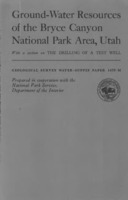Ground-water resources of the Bryce Canyon National Park area, Utah, with a section on the drilling of a test well
Links
- Document: Report (pdf)
- Plates:
- Plate 24 (pdf) Map of Bryce Canyon National Park area, Utah, showing physiographic features and the location of springs and wells
- Plate 25 (pdf) A, Map of East Creek Valley showing area underlain by alluvium; B, North-South section of East Creek Valley showing inferred maximum depth to bedrock and the position of the water table in May 1957
- Plate 26 (pdf) Logs of the test well at Bryce Canyon National Park, Utah
- NGMDB Index Page: National Geologic Map Database Index Page (html)
- Superseded Publications:
- Download citation as: RIS | Dublin Core
Abstract
The water need at Bryce Canyon National Park in 1957 was about 1.3 million cubic feet for a tourist season that lasted from the middle of May to the middle of October. To evaluate the adequacy of water-supply sources, a hypothetical future need of 5 million cubic feet of water per season is used. This amount of water might be obtained from the East Fork of the Sevier River, from wells in the alluvium of the East Fork, from Yellow Creek Spring and nearby springs, which are below the canyon rim, or from a well drilled about 2,000 feet to the top of the Tropic shale. Although the present source of water, consisting of wells in the alluvium of East Creek valley, may be an important supplemental source in the future, it will not yield sufficient water in dry years to meet the total demand for water at the park.
The yield of Yellow Creek Spring and nearby springs is estimated at a total of 7.8 million cubic feet of water per season. The springs provide water of satisfactory chemical quality, and are a reliable source even in times of drought. A serious disadvantage of using this source of water is the difficulty of constructing a pipeline over extremely rugged terrain from the source to the lodge and headquarters area.
A well drilled to the top of the Tropic shale of Cretaceous age in the lodge and headquarters area might penetrate two or more aquifers, one at the base of the Wasatch formation of Eocene age and one or more in the Wahweap and Straight Cliffs sandstones of Cretaceous age. The yield of this well would depend to a large degree on the number of fractures encountered. To assure the most favorable conditions for intercepting fracture zones in the bedrock, a test-well site is proposed near the crest of a gentle anticline where tension fractures in the rocks should be common.
Shallow wells in the alluvium of East Creek valley cannot be depended upon to yield sufficient water in times of drought, but they are nevertheless an important source. The water-storage capacity of the alluvium of East Creek valley in the vicinity of the wells of the Utah Parks Co. is estimated at 1.4 million cubic feet. By lowering the water table in the valley uniformly without creating excessively large cones of depression, the alluvium could supply the 1.3 million cubic feet of water per season estimated as the water need in 1957. However, in times of drought this alluvium cannot supply the hypothetical future needs of 5 million cubic feet of water per season.
Study Area
| Publication type | Report |
|---|---|
| Publication Subtype | USGS Numbered Series |
| Title | Ground-water resources of the Bryce Canyon National Park area, Utah, with a section on the drilling of a test well |
| Series title | Water Supply Paper |
| Series number | 1475 |
| Chapter | M |
| DOI | 10.3133/wsp1475M |
| Year Published | 1963 |
| Language | English |
| Publisher | U.S. Geological Survey |
| Publisher location | Washington, D.C. |
| Contributing office(s) | U.S. Geological Survey, Utah Water Science Center |
| Description | Report: iv, 46 p.; 3 Plates: 16.20 x 24.41 inches or smaller |
| Larger Work Type | Report |
| Larger Work Subtype | USGS Numbered Series |
| Larger Work Title | Hydrology of the Public Domain (Water Supply Paper 1475) |
| First page | 441 |
| Last page | 486 |
| Country | United States |
| State | Utah |
| Other Geospatial | Bryce Canyon National Park |


